‘Pure terror’: COVID-19 on the front lines of Ukraine’s war
In Europe’s only active war zone, closed borders and a lack of resources are impeding the fight against COVID-19.
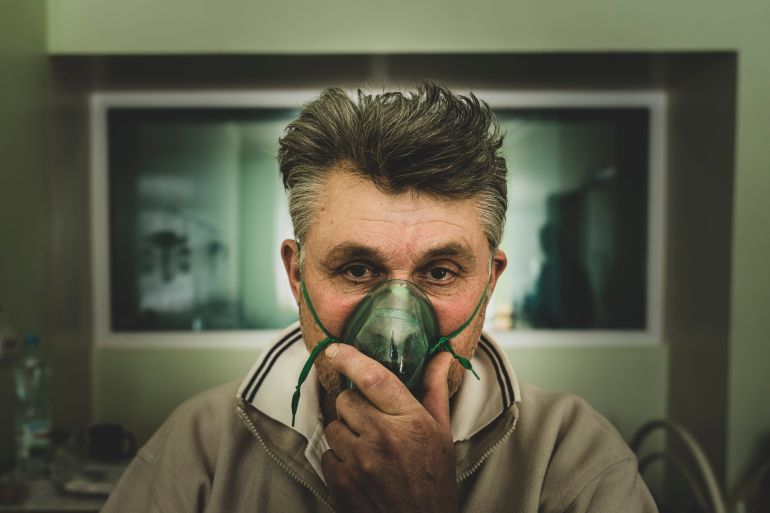
Paediatrician Victoria Koryak meets us on the second floor of the district hospital in the town of Stanytsia Luhanska. Divided into two parts – one under Ukrainian control and the other part of the pro-Russian separatist Luhansk People’s Republic – the town in the Donbas region is on the front line of the war in eastern Ukraine.
Koryak wears sky-blue scrubs with floral embroidery, her ash-blonde hair gathered under a cap. She stands near the entrance to the hospital’s “red zone”, the area where coronavirus patients are treated.
Keep reading
list of 4 itemsWhat will it take to stay one step ahead of a mutating COVID-19?
A geneticist’s biggest challenge: Curing his own son
‘Worse than war’: Health workers on a year of the pandemic
“I won’t go in there again. I’ve already been in today. My hair stands on end when I think about going back,” says the 55-year-old, passing one hand over the other as if rubbing away goosebumps. She confesses that she asks a nurse to inject her with a sedative after each visit.
The children’s section of the hospital has been repurposed for COVID patients, with the children’s beds that are no longer in use huddled in the corners of the rooms and Soviet cartoon characters decorating the green painted walls. As the only hospital serving the town’s 13,089 people, it was overwhelmed during the peak of the pandemic last year but is quieter this winter afternoon.
Koryak reluctantly agrees to show us around. In what used to be the children’s cafeteria, she strips down to her underwear and dons white overalls and a respirator mask labelled “BUK-3” as we follow suit.
“This inscription evokes bad associations,” sighs Koryak, referring to the BUK missile system – whose name has no relation to the mask label – that hit the Malaysian Boeing MH-17 over the Donbas region of Ukraine in 2014, killing 298 people.
Passing through the polythene curtains that divide the “clean” and “red zones”, Koryak warns us that we “are going into the trenches”.
Staying behind
In 2014, when the war between the Ukrainian army and the pro-Russian separatists of the so-called Donetsk People’s Republic and Luhansk People’s Republic, both in the Donbas region, which had declared independence from Ukraine that year, was at its peak, a shell hit the children’s section of the hospital.
Koryak recalls another occasion when a shell flew over the hospital. She was helping deliver a baby at the time. “The gynaecologist stood with her back to the window, and I was there with the mother and … it was like having a fireball flying right at you. I’ve never had such a rushed delivery in my life,” she says.
A wooden screed remains, supporting the wall of the ICU damaged by the blast.
Koryak, who has lived in Stanytsia Luhanska since 2000, was one of the few doctors who remained during the fighting.
The others were mostly surgeons who had to work 48-hour shifts treating soldiers and civilians caught up in the war. Doctors like Koryak were on hand to carry stretchers and care for the wounded and frostbitten – for nine months the town had no electricity and, during that first winter of the war, temperatures dropped as low as -24C (-11.4F) – as well as psychological disorders triggered by the conflict.
According to the UNHCR, approximately 13,200 people have been killed in the conflict in Ukraine, about a quarter of them civilians.
Koryak’s house was damaged during the conflict, but she has yet to rebuild it as sporadic shooting still takes place in the nearby forest.
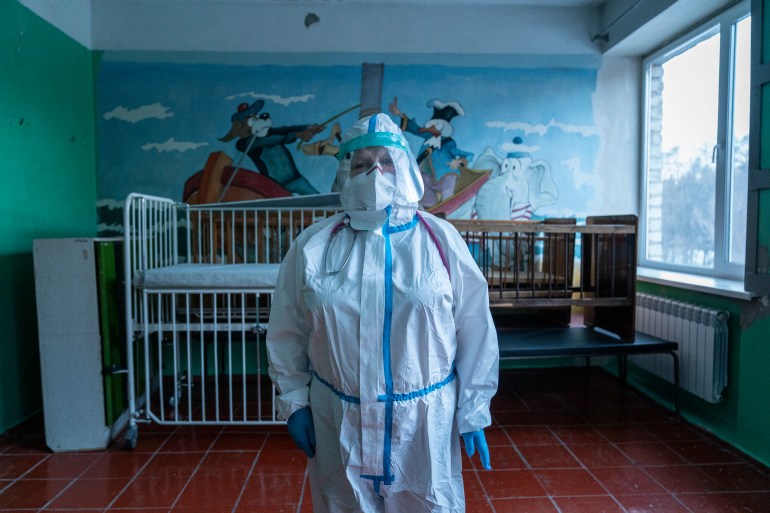
Peak of the pandemic
Now, a different sort of urgency permeates the unit.
Since the start of the COVID pandemic in March 2020, Ukraine has counted more than 1.3 million cases, with 50,625 in Donetsk and 15,635 in Luhansk.
When cases spiked between October and December of last year, many hospitals in eastern Ukraine were overwhelmed. There was a shortage of staff as many doctors had moved away because of the war or the pandemic.
In the winter months, hospitals also struggled with oxygen supplies as oxygen cylinders froze and had to be warmed with water.

Until February, Stanytsia Luhanska had been designated a “red level” danger area – meaning it had high rates of transmission and more than 75 percent of its hospital beds were filled.
Koryak tells us there was a period when all 20 oxygen generators they had were in use, with only one nurse on shift to look after those patients.
They also improvised IV poles, using sticks with plastic bottles turned upside down to hold the fluids.
Almost everyone working at the hospital has had COVID, despite wearing protective suits and masks. In December and January, Koryak had a bad case, with low oxygen saturation and a high fever, but she stayed at home with her husband, who had a milder case of COVID, paying almost $800 for medication she bought at the pharmacy.
“For several days I was preparing to die and watched YouTube videos about how to die with dignity because I saw how people die at the hospital – in panics from the lack of oxygen. I have a full stack of death cases on my desk,” she explained.
According to Koryak, there is no medical insurance for medical personnel. And although basic treatment in COVID hospitals is provided free of charge as part of the country’s national healthcare, patients often have to buy their own medicines. Sometimes this can cost the patient $3,000 to $4,000, an unthinkable amount for someone on a minimum pension of $64 or an average salary of $235 a month.
“When I think about the coronavirus, I feel a chemical rush of pure terror. I wasn’t afraid of going to work under shelling, I knew that I could lie by a curb or hide in a ravine. Meaning, you always had a chance. But when you’re working with the coronavirus, you know that your chances of escaping it are next to none. There is no such thing as getting lucky. Coronavirus will 100 percent hit you,” she reflects.
At the checkpoint
On the outskirts of Stanytsia Luhanska, where Ukrainian government troops sit just two kilometres from their Russian-backed opponents across the river, marking the boundary between government-held territory and the self-declared Luhansk People’s Republic (LPR), a checkpoint allows civilians to cross the border on foot.
Barbed wire is strung along a rickety frame enclosing a narrow passageway leading through the no-man’s land. Inside, several hundred people are packed in like sardines, waiting to enter government-held territory.
“No pushing, please no pushing. Keep a metre and a half apart,” a Ukrainian border guard calls out. Nobody seems to hear him. Some have masks hanging under their noses, while others have them pulled over their foreheads.
The government has just reopened the checkpoint after a two-week lockdown and people who live on the other side of the border are flocking to cross. Many have come to undergo state identification procedures so that they can continue receiving their Ukrainian pension. Others are seeking medical treatment or admission to university, or visiting family or attending funerals. Everyone who crosses is required to undergo two weeks of isolation and to install an app on their phone that allows the state to track their compliance. That is, unless they can pay for a rapid test that proves they are COVID-negative.
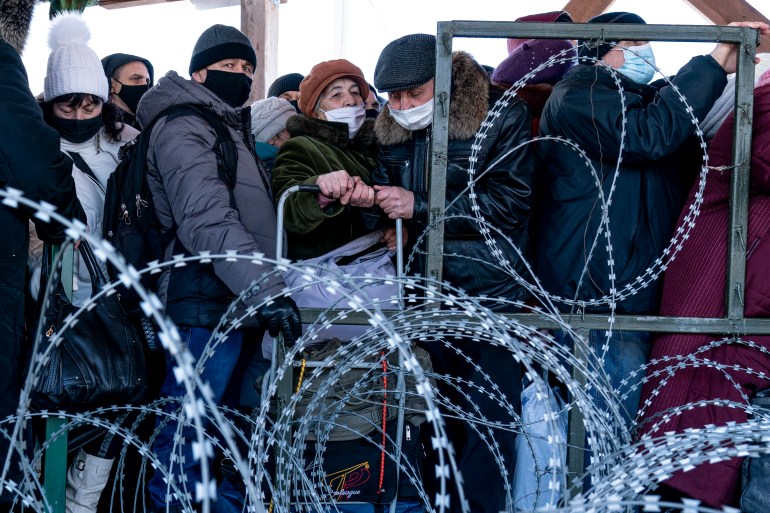
Travellers clearing the checkpoint are immediately met by drivers for hire, waiting to walk them to two nearby testing centres. Each test costs 1220 hryvnia ($44), a steep markup from the 700 hryvnyia ($25) that people generally pay in Kyiv. Those without smartphones, and who cannot afford the test, are sent to state medical facilities for two weeks of observation.
One hundred metres (300 feet) from the checkpoint are two mobile laboratories where people can take PCR tests.
Near one of the test booths, Sergiy Bohatyryov, 63, sits in his wheelchair and lights a cigarette while his wife registers and pays a cashier. A laboratory employee squeezes through the queue and asks him to throw out his cigarette before his test. His wheelchair, it turns out, does not fit into the tiny booth, so he takes the test in the open air, amid crowds of people and scurrying stray dogs.
Bohatyryov, who is retired and comes from Luhansk, says crossing the checkpoint is hard, and tells us, sadly, that this is “probably the last time”. To pick up his pension, he will have to first get tested, then pay to stay overnight in the village waiting for his results, and then brave the lines at the pension office. While his pension is 2000 hryvnyia ($72), the cost of making the trip amounts to 1320 hryvnyia ($47) and will leave him with just 680 hryvnyia ($24) – it is a lot of trouble to go through for such a small amount.
Back at the hospital, Koryak estimates that when the checkpoint reopened last year after a lockdown, about 80 percent of people who crossed over from the separatist-held areas and requested tests were COVID-positive. Now that another lockdown has ended, she fears infections in Stanytsia Luhanska will spike again.
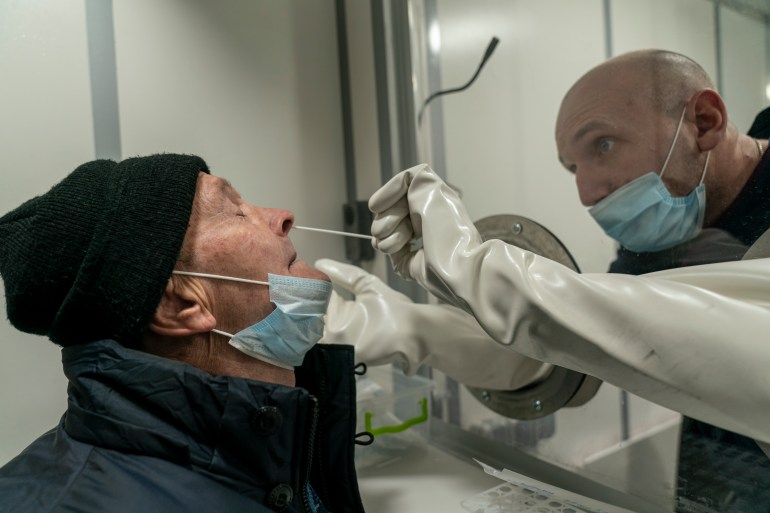
A two-day drive to get home
If crossing the front line from LPR areas is a burden, residents of the so-called Donetsk People’s Republic (DPR) to the south – the other Russian-backed breakaway region – have it worse.
To get to government-held areas – even places that, prior to the war, would have been a half-hour’s drive from home – DPR residents now have to make an illegal trip across two borders.
Travelling for two days, passengers sit in crammed, eight-seat minibuses that take them through Russia and then Ukraine, passing customs checks and paying an estimated $21 to border guards to cross illegally. Along the way, drivers pick up medicines to take back to the breakaway republics.
Up until February 26 Ukraine’s ministry of health designated Russia as being in the “red zone” and required minibus drivers to take regular PCR tests since they drive across borders every two to three days. But this, like some of the other COVID measures, simply became an additional opportunity for bribery, as drivers paid off border guards in order to be allowed to pass.
When 32-year-old Katerina, who lives in the Ukrainian capital Kyiv, heard that her mother got COVID-19 back home in the separatist-held city of Donetsk, she immediately tried to travel there.
Since the death of her father five years ago – for reasons unrelated to the war – Katerina had not been home. The memories of having to leave war-torn Donetsk were too painful and she wanted to close that period of her life forever. She had planned to relocate her mother to Kyiv but the long trip would be difficult for her mother and the pandemic delayed things further.
Travelling back home, tired and cold, she feared that by the time she reached her mother she would hear that she had died. “War is not scary when there are more basic things [that can happen],” she reflects.
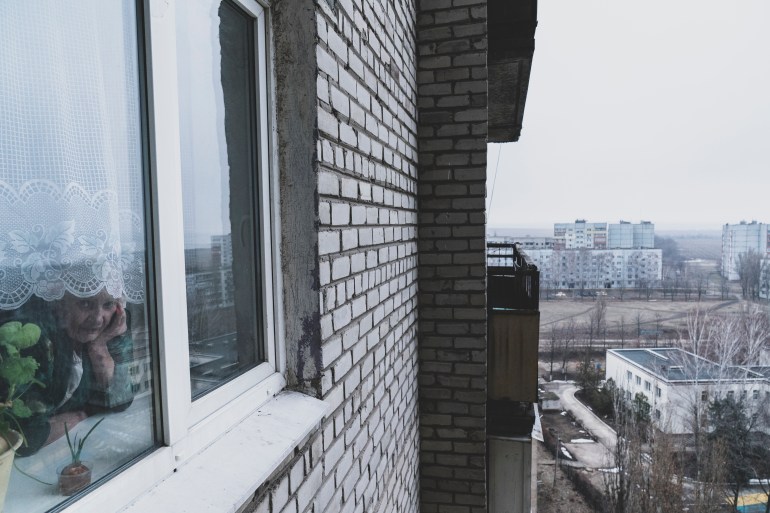
Initially, her mother had been cared for at home under the supervision of a doctor but her oxygen levels dropped to 70 percent and she was hospitalised. By the time Katerina reached Donetsk, making the two-and-a-half-day trip through Russia, her mother was in serious condition and had been placed in intensive care with extensive bilateral pneumonia.
Family members of COVID patients got news from doctors who spoke to them in the waiting room three times a week, allocating three minutes for each. She was surprised by how caring the doctors were despite the past seven years of war. In a place where tragedy was normalised, “you won’t surprise anyone with death,” she says.
In the weeks since Katerina’s mother was admitted to the hospital, they have created their own way to communicate, passing each other daily letters via a nurse. Her mother has written about how difficult it is to see someone dying every day, and the shock of seeing elderly patients bound to their beds so they cannot take off their respiration masks.
Katerina recalls that one day a nurse was giving out prescriptions to family members to buy for their infected loved ones; when one woman did not receive anything, she asked the nurse why, and the nurse replied: “Nobody called you? Your father died yesterday.” The woman fell to her knees and cried.
Little information is known about how many cases there are in the breakaway territories. While the separatist leadership has reported a total of 25,959 cases, the number is believed to be much higher.
According to human rights activist Pavel Lisyansky, who monitors the situation in the breakaway republics, there are about five times more patients with coronavirus in the Luhansk and Donetsk People’s Republics than in the rest of the Donbas region. In other words, about 280,000 people, or a fifth of the approximately 1.5 million residents, have had COVID-19.
Borders, checkpoints and the coronavirus
Closed borders, detours and corruption may have helped COVID spread.
Just one kilometre from the front line, coronavirus has made its way into the village of Verkhnetoretskoye, which is only accessible to locals and military personnel.
At its entrance is a dilapidated checkpoint building with a smoking chimney. The golden dome of a church is the only bright spot against a background of grey houses.
Today, a snow-white ambulance drives through muddy puddles under the drizzling rain, travelling on roads damaged by military equipment. Inside, Dr Irina Guzhina – the only doctor for the population of 2,500 – and her nurse are on their way to examine a husband and wife recovering from the coronavirus in their home.
She says many people have been ill in the village, but it is difficult to say the exact numbers as there hasn’t been enough testing.
She knocks on the couple’s fence, which gapes with holes from shell fragments. “Is anybody home?” she asks. Three cats and a Pekingese dog wander around the yard, while two more cats lie curled up in the entryway. Potted houseplants are carefully placed on the windowsills.
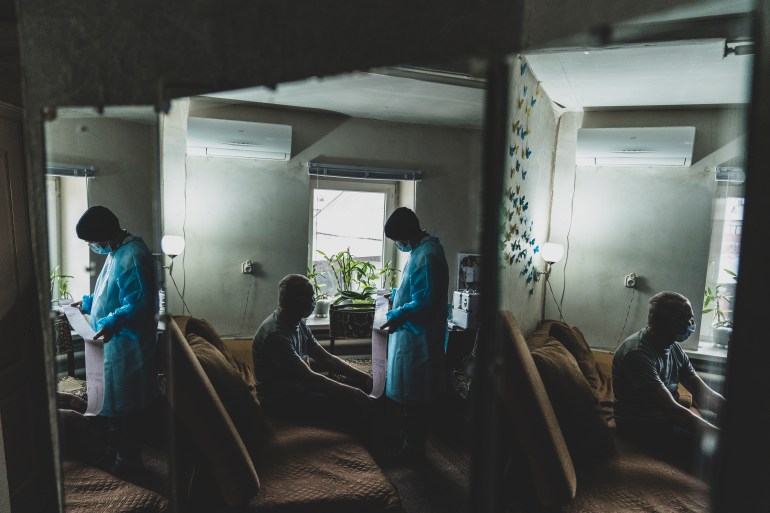
In the living room, the doctor opens her suitcase, takes out a stethoscope and listens to the lungs of 68-year-old Svetlana Kitinskaya. The nurse administers a cardiogram for her husband Victor, 69, sorting through the endless wires of the device.
Both had recently been infected with COVID-19. Svetlana’s case was so serious that she fell into a coma, suffered jaundice and was hospitalised for approximately 10 days. She now struggles with high blood sugar.
Skirmishes on the front line did not help, adding to the fear, stress and anxiety.
“Sometimes we get shelled, sometimes people die here. We have it all. It is very scary, especially when they are shelling. Yesterday there was heavy shelling around Avdiivka,” she says of the nearby town. “I felt tense. After all, they can shoot there but [we] will get [it] here,” says Svetlana.
Guzhina is the only doctor in the front-line village, but she doesn’t dwell on the risks she faces. “I’m just doing my job”, she says.
The infectious ward
Pulling a coat around his shoulders, infectious disease doctor Boris Shishin meets us on an early January morning at the city hospital in Sievierodonetsk, Luhansk region.
We offer our awkward apologies for being late: it is freezing outside, we could not start our car, and a taxi refused to come. “I started the car at -29C. Maybe it’s good that the cold has come. People will come out on the street less, they will not spread COVID-19,” says Shishin.
He brings us to the two-storey grey brick building of the hospital’s infectious ward. A cross is painted on the facade in red, and a sign reading: “Entry to the department is prohibited during the quarantine period,” hangs on the front door.
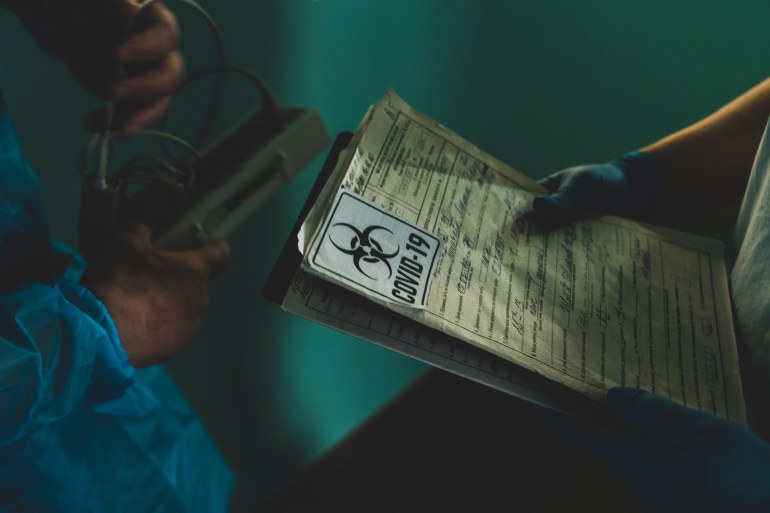
Shishin takes us to his tiny office so that we can leave our things. Then, to prepare for his morning round, he starts putting on his personal protective equipment with the help of a nurse.
While dressing, Shishin talks about the department. On the ground floor, there are seriously ill patients who receive infusion therapy two to three times a day. On the second floor is the so-called “dirty zone” for patients who are in recovery. There are also COVID-19 patients in other departments, depending on their symptoms. The intensive care unit is located in a separate building on the sixth floor. There is also a morgue on site.
With just three infectious disease doctors on site, his department is handling 150 percent of its usual capacity, treating 46 patients when they are equipped for 30.
During the peak of the epidemic, Shishin himself fell ill with COVID but he isolated himself in his small office, sleeping there and giving recommendations to medical staff and patient consultations over the phone for four weeks.
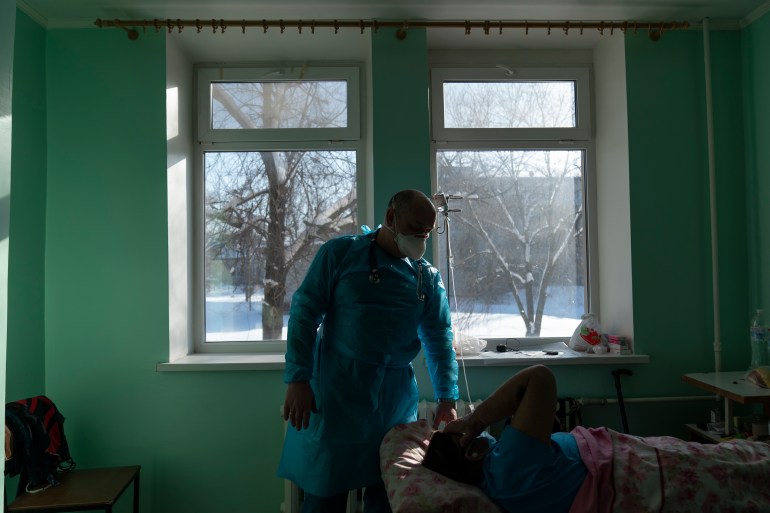
‘I could hardly breathe’
After exchanging a few words with some nurses, Shishin begins to examine the patients, talking and joking with each.
We stop by the bedside of 54-year-old Vyacheslav Oskolkov, who was admitted on New Year’s Eve and required intensive care, spending several weeks laying on his stomach to make his breathing easier.
“They brought me with a temperature of 40, I could hardly breathe. You can imagine what I felt laying in intensive care,” he recalls.
Now his condition has stabilised, but he still cannot walk, in fact, he can barely stand, and must wear a special mask to strengthen his lungs.
Vyacheslav had been sceptical about the coronavirus but realised the disease was not a joke.
Doctor Shishin explains: “I would say that he was one foot in the grave. And we managed to get him back from there. He is not among the dead. And now [his health] is getting better every day.”
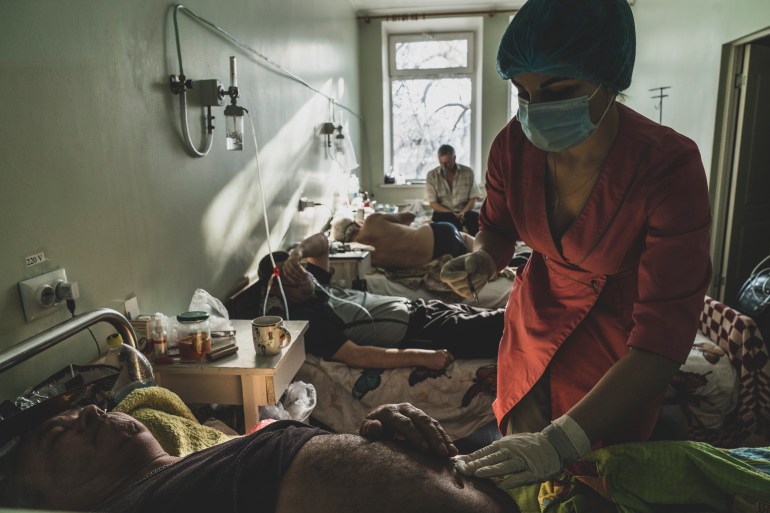
A pink coffin
The morgue is diagonally opposite the infectious diseases department.
Here, relatives say farewell to those who died of coronavirus.
We spot a small group of mourners waiting outside and ask permission to be present at the funeral service. “Please. It won’t help her anyway,” says the daughter of deceased 67-year-old Galina Borovskaya.
The priest, who wears no mask or PPE, ushers the family in and asks them to move several metres away from the closed pink coffin. He speaks words of consolation and conducts a funeral service for the relatives wearing thin masks and holding candles.
After 10 minutes, undertakers enter in white protective suits and masks. They take the coffin and drive it to a cemetery in Syrotyne village, eight kilometres from the city. The relatives follow in two vehicles.
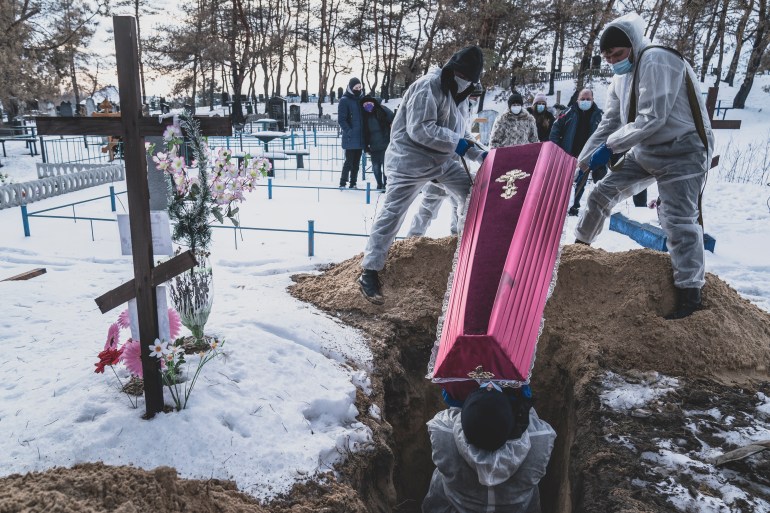
The whole process – from leaving the morgue to the burial – is very fast. We follow the undertakers and relatives to the cemetery where they take the coffin out of the car, their white protective suits blending with the snow on the graves. They ask the relatives to stay several metres behind.
There are a few minutes of goodbyes as Galina’s daughter cries and her brother takes her away from the coffin.
The undertakers’ movements are well-coordinated: they quickly lower the coffin, throw clay soil on top, put up a cross and place the siblings’ two wreaths on the fresh grave.
Some minutes later, as the sun sets, everyone must go, leaving Galina’s pink coffin resting in the earth.